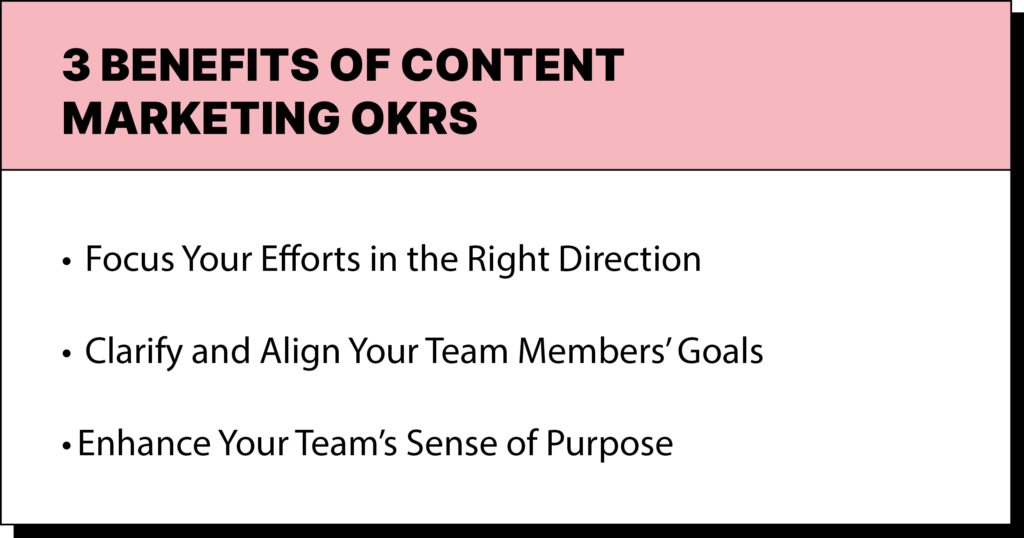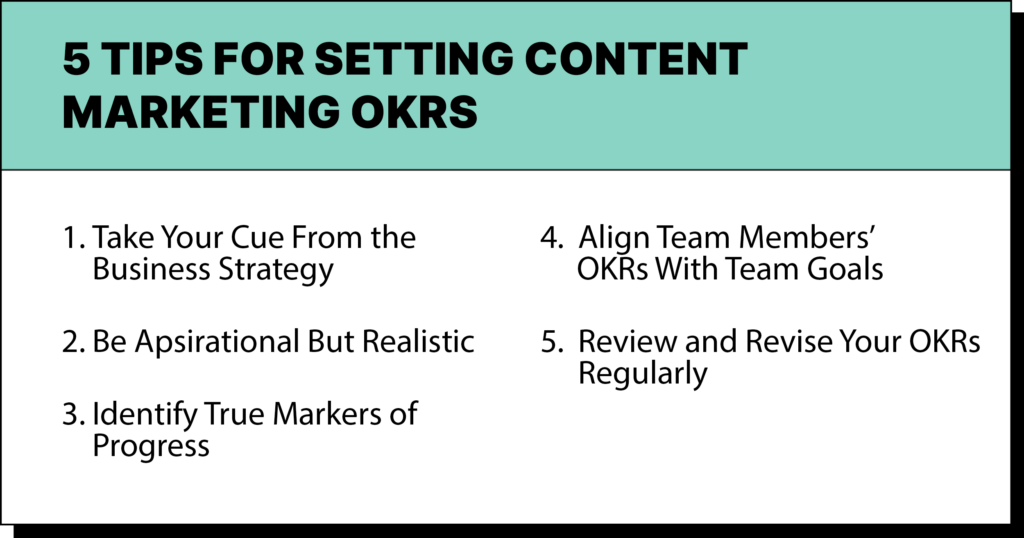Setting content marketing OKRs isn’t a task to take lightly. There’s an art and a science to making objectives and key results that move the needle on your content strategy. How can you maximize your team’s goal-setting process and set them up for success?
As you consider your team’s long-term goals and short-term objectives while driving business value, use our guide to take your content marketing OKRs to the next level.
Defining Content Marketing OKRs
Companies have many goal-setting frameworks and approaches available to them. You’ve probably experienced a few of them. What differentiates OKRs is that they identify goals and specify how you’ll achieve them in a set time frame.
Originating with Andy Grove at Intel, OKRs align departments, teams and individual contributors across shared priorities. The framework was refined by John Doerr, who famously introduced OKR to Google in 1999. Google continues to use OKRs and credits them with much of its success). OKRs are industry-agnostic, so you don’t need to work in Silicon Valley to benefit from them.
Let’s break down the basics of OKRs for content marketing.
Objectives
Objectives are what you hope to achieve. They tie directly into the business strategy. They outline what the content marketing team needs to accomplish to help the business achieve its goals. Setting good objectives forces you to be thoughtful about how your work drives business value.
Key Results
Key results are markers of progress toward your objectives. They help you see, at a glance, whether you’re meeting the goals you’ve set.
If you need a primer to get started, consider this OKR goal-setting framework to align your content marketing work to larger business goals. The framework also helps you align individual team members across shared goals.
What Content Marketing OKRs Aren’t
OKRs can take a little while to understand and apply. That’s OK! One way to understand this framework is to talk about what OKRs aren’t. Then you can home in on what’s relevant.
Key Performance Indicators
Although similar, OKRs and key performance indicators (KPIs) aren’t the same thing:
- KPIs are closer to key results in that they indicate progress but are only part of the solution.
- OKRs go further than KPIs, providing an overall framework for setting and achieving goals.
KPIs are metrics without direction. They’re often something you measure, like the number of visitors to your site or inbound leads. That data can be helpful, especially when matched with clear goals, or objectives, that give those numbers meaning. OKRs can structure KPIs and metrics in a powerful, visible and easily understood way that serves your entire organization and your content marketing team.
A To-Do List
OKRs aren’t a to-do list, either. Thinking of them that way diminishes their strategic value. It’s tempting to write key results as a list of items to cross off, but that’s also a misinterpretation. Key results are the outcomes of actions taken, not the output itself.
For sure, your key results might contain steps to take, but don’t let that confuse you. Tasks are included in your OKRs because they’re part of achieving measurable results (sometimes called “input key results,” or input KRs).
Suppose your objective is to build engagement on Instagram. In that case, one of your key results might be to interact with followers daily. The key indicator is growing engagement (a metric), not “I liked some posts and replied to some comments” (an action).
Your Content Calendar
Although many of your goals will directly affect the content you plan to produce, OKRs aren’t a content calendar.
Content calendars and OKRs have different purposes. Your content calendar lays out your production schedule, identifies the purpose of each piece and helps you keep track of who’s doing what. Content calendars facilitate timely and effective content production.
OKRs are designed to help you drive business results. They help you keep your priorities aligned with the business’s while tracking progress over time. While OKRs can overlap with your content strategy, they deliver additional benefits. You might set an objective related to increasing your team’s engagement, for example. That’s not something a content calendar will address.
3 Benefits of Content Marketing OKRs
Let’s look at three benefits specifically for content marketing teams.
Focus Your Efforts in the Right Direction
OKRs play a crucial role in helping your team prioritize what’s most important. You might have several team members prioritizing different projects. Your OKRs align that activity in the most productive way. OKRs outline three to five goals that tie directly to the business strategy for your team to accomplish in a given time period. These goals focus — and align — your team’s efforts on actions that have the biggest impact on business results.
Clarify and Align Your Team Members’ Goals
OKRs are instrumental in helping you communicate larger goals to team members, who can then identify personal goals that push the team’s objectives forward. Setting OKRs should be a collaborative process between employees and their managers. When your team members understand the content marketing team’s objectives, they can see where they fit into the bigger picture, and what they need to accomplish.
Enhance Your Team’s Sense of Purpose
One of the most powerful benefits of OKRs is increased visibility into how your team supports the business strategy. This is especially important in larger organizations, where employees can feel lost or disconnected from the broader mission. When workers understand how they deliver value to the team and the company, they’ll likely have an increased sense of purpose, which influences employee engagement and your culture.

5 Tips for Setting Content Marketing Goals and OKRs
Meaningful OKRs connect directly to business needs. As you consider OKRs for your content marketing team, consider these best practices.
Take Your Cue From the Business Strategy
Content marketing is about creating and distributing content that supports and drives the business. To set relevant OKRs, you must align your content marketing goals with the overall strategic plan.
Start by answering the question, “What can our team do to move the business’s goals forward?” Your answer will inform your priorities.
Because content marketing is under the marketing umbrella, sync up with other marketing team leads (if you have them) to ensure your goals support the department’s. Ideally, the department also has OKRs that support the larger business, and the entire effort is a collaborative process between marketing leaders.
Be Aspirational, But Be Realistic
Content marketing is a long game. You might not see results within the standard time frame for achieving OKRs (typically three months to one year). And yet you don’t want objectives that are too easy. If you’re already producing one blog post a week, an objective to keep doing that is specific, measurable and realistic, but so what? It’s not pushing you forward, much less the team or the business.
Look to set goals that have a mix of short-term and long-term benefits. An OKR around hosting a set number of webinars during the year, for example, will likely see faster results than one involving ranking higher for competitive keywords on search engines. Better still, think about how the number of webinars or keyword improvement can be key results that funnel up to a higher-level objective.
Devote Time to Understanding True Markers of Progress
OKR frameworks work best when your key results demonstrate progress toward the objective. Many people find setting objectives relatively easy compared with finding the appropriate key results. That last part can be the most challenging part of setting OKRs.
It’s OK to take time to reflect on your key results. As you set objectives, consider what metrics you’ve used to monitor these or similar projects. That knowledge can help you land on meaningful metrics that track and demonstrate your progress.
Learning to write good content marketing OKRs takes time, but that’s a small tradeoff for the benefits. Give yourself the time and space to reflect on your team’s past performance and where you want to create targeted growth.
Align Each Team Member’s OKRs With Team Goals
To determine each team member’s OKRs, follow a similar process to the one you used to determine team or department OKRs. This is a collaborative effort. You need input and guidance from employees to understand what they’re most interested in accomplishing. Managers make sure employee OKRs align with the business and each person’s talents, interests and role.
Besides aiming for established output-based goals, the OKR process is an excellent opportunity to implement cross-training, upskilling, learning and professional development.
Review and Revise Your OKRs Regularly
Business goals change, sometimes without warning, and your content marketing OKRs are no exception. If your business pivots or acquires another company, for example, your team’s priorities will change. Whatever the reason, you’ll need to reassess your OKRs to ensure the team is focused on the right things.
Sometimes, you’ll realize some or all of your quarterly OKRs are the wrong fit. That can be discouraging, but be gentle with yourself. Writing good OKRs is difficult! Many organizations find it takes three or four cycles to get comfortable with the process.
If you feel you’re headed in the wrong direction, it’s never too late to reassess and revise your key results and, in some cases, even your objectives.

3 Content Marketing OKR Examples
To help you better understand how to use OKRs in content marketing, we came up with a few examples.
Objective: Improve Brand Authority Via SEO
- Key Result: Improve search engine rankings by publishing a weekly piece of long-form content targeting a relevant keyword.
- Key Result: Increase organic search traffic to your site by 10% month over month.
- Key Result: Reduce the bounce rate of your organic web traffic by 5%.
Objective: Increase Engagement With Newsletter Subscribers
- Key Result: Increase the open rate on weekly newsletters by five percentage points by writing better subject lines and running A/B tests.
- Key Result: Improve your calls to action (CTAs) and/or add visual elements to improve click-through rates by two percentage points.
- Key Result: Improve deliverability by reviewing subscriber data, scrubbing inactive emails and making sure new subscribers are opt-in.
Objective: Build Out an Influencer Marketing Strategy
- Key Result: Make meaningful connections with one or two industry influencers per week.
- Key Result: Publish one guest blog post each month from an influencer or thought leader.
- Key Result: Dedicate X hours of a team member’s week to pursuing influencer partnerships and reporting on the results.
OKRs Empower You to Drive Business Value
Meaningful content marketing OKRs help you create more value for the business and show your people why their work matters.
Setting and achieving meaningful OKRs also helps you demonstrate your content marketing team’s value and contributions, which is especially powerful during budget conversations.
Content marketing OKRs give direction to your strategy and your team’s work. And as your team gets more familiar with how they work, you’ll need to think of bigger and better goals — because you’ll be smashing the ones in front of you.






